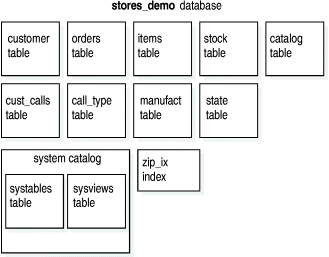
A database is a logical storage unit that contains tables and indexes (see Tables). Each database also contains a system catalog that tracks information about many of the elements in the database, including tables, indexes, SPL routines, and integrity constraints.
A database resides in the dbspace specified by the CREATE DATABASE statement. When you do not explicitly name a dbspace in the CREATE DATABASE statement, the database resides in the root dbspace. When you do specify a dbspace in the CREATE DATABASE statement, this dbspace is the location for the following tables:
Figure 60 shows the tables contained in the stores_demo database.

The size limits that apply to databases are related to their location in a dbspace. To be certain that all tables in a database are created on a specific physical device, assign only one chunk to the device, and create a dbspace that contains only that chunk. Place your database in that dbspace. When you place a database in a chunk assigned to a specific physical device, the database size is limited to the size of that chunk.
For instructions on how to list the databases that you create, see Displaying Databases.
Home | [ Top of Page | Previous Page | Next Page | Contents | Index ]